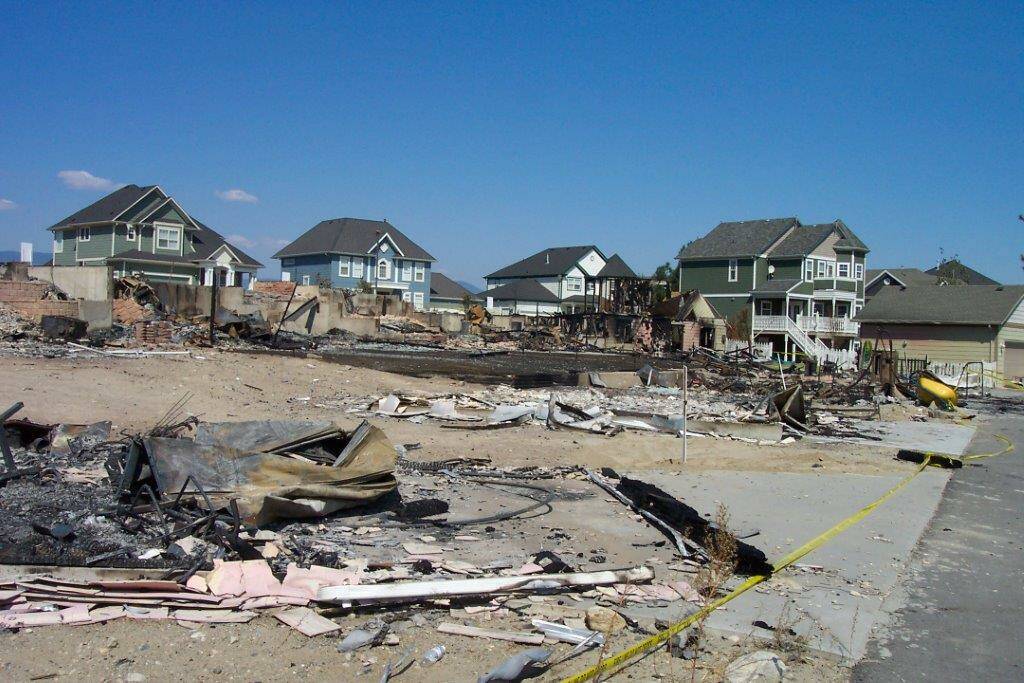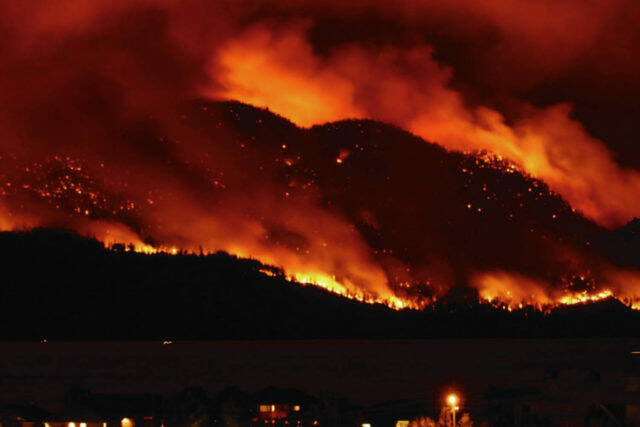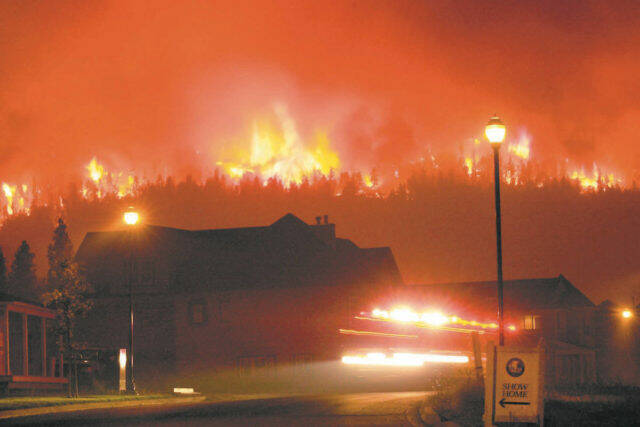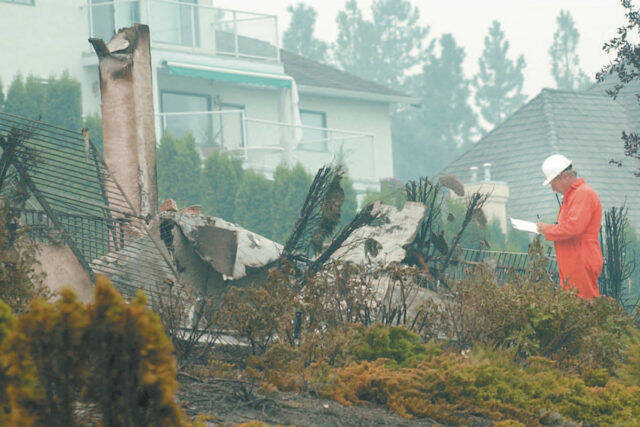All the time.
That is how retired Kelowna fire chief Gerry Zimmermann still responds today when people ask him about the Okanagan Mountain Park fire of 2003.
“People have not forgotten. For those who weren’t living here then, it is hard to explain,” Zimmermann said of those days in August 2003 when the city was threatened by a wildfire initially sparked by lightning in Okanagan Mountain Park.
“Kelowna as a community stood tall when that fire happened. When I think of that fire today, I think about how people reacted, how they helped each other, how people worked together. I remember that more than anything when I am asked about that time.”
Zimmermann is long since retired from the fire department. He went on to serve a term on council, and is now on his second tour of duty as a member of the Agricultural Land Commission.
He also continues to serve on the Black Mountain Irrigation District board and still keeps busy with his farm and managing its small vineyard.
But the fire in 2003 is never that far from his thinking.
“You never forget, you never forget. Two hundred houses burning down in one go. You never forget that” he said.
Zimmermann says he often is asked to speak about that experience to groups, and he tries to offer some perspective on the magnitude of impact when that many homes are lost to fire.
“One of the things I ask if raise your hand if you have seen two houses burn at one time. You get a few hands go up. Then I ask of you have seen three houses burn at once. Fewer hands go up and that is something not seen very often.
“So when you are talking about 200 houses…the magnitude of loss is hard to imagine. In the end, three of our firefighters and one RCMP officer lost their homes in that fire, so for many of us it was quite personal.”
The Okanagan Mountain Park fire was ignited originally by a lightning strike in a remote area of Okanagan Lake Park on Aug. 16.
While the flames were visible on the isolated mountainside, the idea that the fire could be whipped up by the prevailing winds and ultimately destroy 236 homes in Kelowna and force the evacuation of 27,000 Kelowna residents seemed very far removed.
But as the blaze reached the city limits five days later, the Okanagan Mountain Park fire had everyone’s attention – a forest fire with the setbacks of hot, unpredictable summer winds and difficult geographic terrain made it difficult to bring under control.
In 2003, it was Mother Nature that stopped a city plan to bulldoze homes south of Barnaby Road in a desperate last-ditch effort to create a large firebreak that officials at the time believed was needed to save the city.
Faced with a gut-wrenching decision, Zimmermann remembers how the decision to proceed with the plan was made quickly and not one person in the room opposed it, even with the knowledge of what it meant and how controversial it would be.
For Ron Mattiussi, it hit home even more on a personal note as his house was one of hundreds that would have been demolished to create a massive fire break.
“I remember Gerry (Zimmermann) saying to me at the time, if we do this, the city will be in court for 20 years,” recalled Mattiussi, reflecting in a Capital News article 10 years ago about that critical moment in the city’s history.
Despite that, Mattiussi, acting city manager at the time, was willing to take the risk to stop further destruction as there was a fear the flames could reach Kelowna General Hospital.
He signed the request asking the province for permission to bulldoze the homes, but the plan was never implemented.
That was because at that moment, the wind changed direction, the sky opened and the rain began to fall.
“By the grace of God, luck and Mother Nature, things began to change at that moment,” Zimmermann said.
But the change in direction also blew the fire in the direction of Myra Canyon which caused devastating damage to some of the Kettle Valley rail trestles, with many destroyed and since having been rebuilt in what continues to still be an international tourist attraction.
At its height, the fire was fought by hundreds of firefighters, both local and others sent from departments across the province to help, along with forest service fire attack crews, helicopter and water bombers, and even the Canadian Army.
It took teamwork that, while evident on the ground, was not always so evident among the officials from the different jurisdictions.
A now legendary exchange between Zimmermann and a top official with the B.C. Fire Commissioner’s office in Victoria resulted in Zimmermann being told to get in line or he could be replaced.
Zimmermann’s response: “Go ahead and try.”
His attempt to honestly reflect on what was happening with the firefighting efforts in the daily press conferences created national media headlines for days.
Looking back on that time in the media spotlight, Zimmermann viewed it as a positive occurrence because he was emphatic about getting the message out to the public and in particular local residents, about the status of their community, their neighbourhood, and ultimately their homes.
“We had seen in a previous fire in Barriere near Kamloops earlier that summer where an absence of communication was upsetting to people and caused a lot of confusion. We did not want that to happen again,” he said.
“I was certainly not used to being on TV every day as I was a pretty private person before the fire happened…”
But he said when it came to working the forest fire crews on the ground, the relationship was very good, as was the dissemination of information to the public and relationship with the media, credited now as a key to helping the community deal with the fire.
In an event filled with many memorable moments for the fire department, Zimmermann recalled that one fateful night when the fire swept down into Okaview and Kettle Valley neighbourhoods, a firestorm that had never been seen before or since in Kelowna.
“It was frightening…we had a crew in Kettle Valley and we did not think at one point they could get out. But we had strong leadership and they were able to stay calm and find a safe spot.”
There were three crews out that night trying to minimize damage to homes. Besides the Kettle Valley group, another was able to flee to safety south of Barnaby Road, and the other was able to escape by scrambling to the nearby shoreline of Okanagan Lake and being boated to safety,
Twenty years later, for Zimmermann, the lasting impact of the fire Okanagan Mountain Park fire is the importance of communication between those directing the wildfire response and those who are evacuated or facing an evacuation alert.
“The one thing I hope we have learned from the Okanagan Mountain Park fire is the communication part of it, to share the information and get it out quickly as possible to people about what is happening on the ground,” he said.
In the end, despite the loss he feels Kelowna escaped feeling the impact that interface wildfires have caused to communities since the Fort McMurray wildfire in 2016 being one example he cited.
The wildfire that descended on that northern Alberta community became the most expensive natural disaster in Canada’s history.
It burned 579,767 hectares of land and forced the evacuation of more than 90,000 people and destroyed 2,400 homes and businesses.
“Before our fire, you seldom heard of wildfires encroaching into communities, and now you hear it a lot,” he said.
READ MORE: ‘Save the rest of the city’: Reflecting on Okanagan Mountain Park 2003 wildfire
Like us on Facebook and follow us on Twitter.
bcwildfireHistoryKelownaOkanagan





